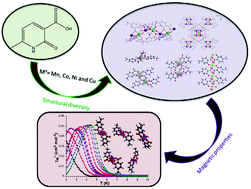Combined experimental and theoretical investigation on the magnetic properties derived from the coordination of 6-methyl-2-oxonicotinate to 3d-metal ions†
Abstract
Five new compounds are reported herein starting from 2-hydroxy-6-methylnicotinic acid (H2h6mnic) and first-row transition metal ions, although H2h6mnic shows a prototropy in solution to lead to the 6-methyl-2-oxonicotinate (6m2onic) ligand that is the molecule eventually present in the compounds. The structural and chemical characterization reveals the following chemical formulae: {[MnNa(μ3-6m2onic)2(μ-6m2onic)(MeOH)]·H2O·MeOH}n (1Mn), {[M2Na2(μ3-6m2onic)2(μ-6m2onic)2(μ-H2O)(H2O)6](NO3)2}n [MII = Co (2Co) and Ni (3Ni)], 2[Cu2(6m2onic)3(μ-6m2onic)(MeOH)]·[Cu2(6m2onic)2(μ-6m2onic)2]·2[Cu(6m2onic)2(MeOH)]·32H2O (4Cu) and {[Cu(μ-6m2onic)2]·6H2O}n (5Cu) (where 6m2onic = 6-methyl-2-oxonicotinate). An unusual structural diversity is observed for the compounds, ranging from isolated complexes (in 4Cu), 1D arrays (in 1Mn and 5Cu) and 3D frameworks (in 2Co and 3Ni). Magnetic properties have been studied for all compounds. Analysis of the magnetic dc susceptibility and magnetization data for 4Cu and 5Cu suggests the occurrence of ferromagnetic exchange, which is well explained by broken-symmetry and CASSCF calculations. The sizeable easy-plane magnetic anisotropy present in compound 2Co allows for a field-induced magnet behaviour with an experimental effective energy barrier of 16.2 cm−1, although the slow relaxation seems to be best described through Raman and direct processes in agreement with the results of ab initio calculations.



 Please wait while we load your content...
Please wait while we load your content...